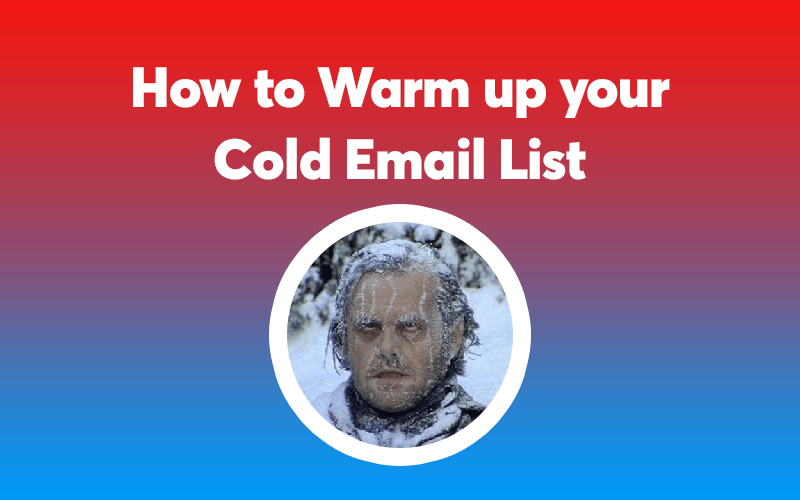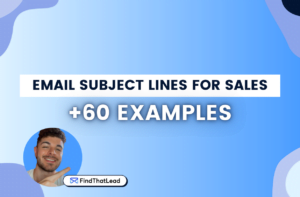The art of email warm up is crucial in today’s digital age. With thousands of unread emails being pushed around every day, understanding how to effectively warm up email campaigns is essential.
With thousands of unread emails being pushed around every day, cold emails are flooding the gates of every inbox. Falling open rates are making this marketing tactic colder than ever and who is to blame?
We ask customers to do things for us before even knowing what they want. We push discounts and offers without even realizing which product works best for them. We as marketers have always treated cold emails as a channel to ask something from the customer instead of offering them something first.
That’s exactly the reason why most cold email campaigns fail.
After running hundreds of cold email campaigns for ourselves and helping others succeed with theirs, team FindThatLead has found the hack in order to warm up a cold email list to turn them into customers in no time!
The Importance of Email Warming in Modern Marketing
Email warming isn’t about marketing gimmicks or flashy content. It’s about building a reputation. When you warm up an email, you’re essentially introducing your email address to Internet Service Providers (ISPs) and email services. It’s akin to a newcomer in town making acquaintances, gradually becoming a recognized and trusted face in the community.
The process involves sending out emails in increasing volumes from a new or less active email address. Over time, this consistent activity signals to ISPs that the email account is genuine and not a source of spam. As this trust builds, the chances of your emails reaching the recipient’s primary inbox increase substantially.
Simple yet effective tactics to warm up a cold email list
Here are some of the cold emailing tactics we use and recommend to all types of businesses. They’re based on the one core value we follow at FindThatLead, and that is to send emails with lots of love!
1. Build your credibility first with your cold email list
Imagine getting an email from a complete stranger that is endlessly talking about their product/ service. You’re probably receiving thousands of such emails every day and trashing them without giving the message a minute. Your cold email list is the same.
Your customers need to trust you and for that, you need to build credibility by going beyond what you sell and offer something that adds value to them first. Also ensuring that they don’t see you as a complete stranger, introduces some level of familiarity with them, which makes them want to read what you’re offering.
For example, If you run a luxury interior business, instead of always sending them ‘get consultation’ or ‘get 50% off on our services’ kind of emails, you can send them ‘10 tips to get your home to feel luxurious’ instead.
This basically builds trust because you’re not pushing them to make a purchase right away. You’re focusing on helping them make an informed purchase decision without expecting them to buy from you.
Your goal here is to add value in such a way that they start to trust your authority in the niche.
As far as familiarity is concerned, any form of social proof – a famous customer that links you to them, an investor, or a mutual LinkedIn connection, helps start a conversation!
That’s why is also key to choose the right audience. Leave aside “the more the better” pattern as not all will be interested in your product. This will translate to a higher open rate and will save you from ending up in their trash bin.
2. Create a relationship with your cold email list with free resources
Certain items require a deeper investment both in terms of cost and the time of the customer simply because of the importance of the purchase.
For example, if you’re planning to purchase a car, you want to be sure you’re making the right purchase as you’ll be taking a loan for the same. You don’t want to mid-way realize that it isn’t something you wanted.
The same holds true for SaaS products – nobody wants to sign up for a subscription model unless they’re absolutely sure the product/ service will add value to them continually.
This is where a successful cold email campaign catches on with content. Instead of a discount on your product/ service, offer a free resource to your prospect. It could be a free ebook about how they can solve their day-to-day challenges, a printable checklist, and so on.
The only aim here is to provide the prospect with a piece of content that will be useful to them. You’re not trying to book a meeting or see if they’re interested in your product.
Think of this as getting a chance to test drive a luxury vehicle before you even start thinking about investing in it.
3. Make it conversational
Communication is key here and language is the most important card of the game. People want to talk to people. They want to be understood, they want their problems to be identified and their goals to be seen.
A great performing cold email campaign is one that is personalized to the last detail. According to a study, personalization improved response rates by a whopping 50% or even higher in some cases. But personalization isn’t just about the first name in the subject line, or how you tailor the message to a prospect’s needs. It’s also about how you talk.
Here are a few tips from us to email warm up:
- Don’t be robotic – people like talking to other people – so when you sound ‘hey we do this because we see a challenge in this’ there is a greater likelihood of people reading your email as compared to ‘we solve this for you’.
- Customize and Personalise– You can almost double your response rate by personalizing your emails. The key here is advanced personalization. You need to include elements that show you’ve written the email specifically for your recipient, rather than sending them a generic message from a big blast. This includes their first name, a reference to the role they play at the organization they are in, their end goal, and so on. You can even show your customers you have done a research about them and you have put some effort on getting to know them.
- Warm-up to your customer– Build a rapport with them, find some common ground like an influencer they follow or a common LinkedIn group. A little informal talk will help your customer ease down and open up to you. Sometimes, all you need is a great brainstorming session to be able to turn a cold lead into a free trial, and then a customer.
- Know their pain points– While being casual will get you a brainstorming session, a lot of your prospects would only indulge in it when there is something concrete to talk about. That’s where talking or addressing the prospect’s pain points comes into play. Your cold email should hit the nail on the challenge the prospect is facing, and offer a solution to it, without overpromising or coming too strong. It’s not a sales pitch. It’s a discussion around their pain points.
We know this technique might take up a lot of your time. After all, no two prospects are the same! But being able to strike up a conversation with 2 out of 10 prospects is a lot worth more than being marked as spam for seeming non-contextual.
4. Try not to sound like a template
Customers receive thousands of emails daily. Even though templates are suitable inn some occasions, your email should ease your customers marketing routine; so give them something challenging, genuine and unique that makes you not sound like any other company. For sure this will mean a higher response rate.
5. Share success stories with your cold email list
People believe what they see. It’s fair for a customer to not truly believe the multiple success figures that flood their inbox daily. Or the ad campaigns they’re targeted with on social media and the search engine.
Simply stating that ‘we will help you achieve a growth of 25% in a quarter’ won’t work because those words are as true as the next email that assures a 40% growth!
How do they believe you?
By seeing it for themselves. By picturizing themselves in the story. Case studies and testimonials from your previous clients are a huge asset here. It gives the prospect something to picture themselves in, making it way easier for them to see the value in what you’re offering.
Make sure you get a personalized testimonial from the customer you’re sharing a case study of, for that extra touch!
6. Make your cold email list an offer they cannot refuse
A typical B2B sales cycle includes 7 decision-makers. So before a prospect or a prospect company signs up for a subscription to your product/ service, your value proposition changes hands a few times. Since each decision-maker here has different goals, the conversion takes way longer.
No one wants to make any subscription-related commitments without being double sure that it serves everything they need.
That’s where you need to offer something to your prospects that require no or very little commitment on their part but that has incredible value for their business. For example:
- Offers and Discounts– You can offer them a discount on a paid plan so that they can go through the features of your product/ service at the least cost. Offer a weekly/ month program based on the type of product/ service you’re offering.
- Trials– You can offer them a trial period with multiple strategies. It will help them experience your product with the least commitment attached to it. You can also use this trial period to personally onboard them and make sure they see success with your product/ service.
Ex. – Basecamp, a project management software, lets its users take their product for a credit card-less 30-day test run before they decide to commit to it. The users can go through all the features and experience them on their own before making a purchase decision. An extremely clever way for project management software to gain leads.
Offers and trials are great to offer value to your customer but it quickly becomes a slippery slope if you don’t go back there and reaffirm your position.
This should be followed by a warm follow up email explaining why you are extending this offer to them and how you would like to convert them to a paying customer as soon as the trail ends or even before that. However, if your message is explicitly focused on selling, you are likely to scare your potential customers away, especially if you have not yet built trust with them. People like to buy, but they don’t like to be sold to. So focus your message on giving, not selling.
7. Take care of the time you send your email.
People usually underestimate this is issue but sometimes it is as important as another. What’s the point of sending an email at an hour where they are least engaged to the phone? Let’s be clear, they are not going to check their email at 10:00 p.m. and remember to answer you the next day. That email is going to begin to go down and down…
You can use your common sense to predict the timing. Think that the majority of prospects are likely to check their emails first time in the morning while having a cup of coffee. This would mean that, more or less, 10:00 a.m. would be the perfect hour. Just, be creative and check it out!
8. Keep your emails short and don’t forget to add your signature.
Let’s be honest: neither you nor I like to read long texts. The best way to deliver an email is to be clear and concise. Address what your customer wants to hear (probably a solution to their pain points) and if you need to talk about anything else, just have a call later on.
Moreover, don’t email your prospects from your personal account, my recommendation is to use a branded email. Your customers would like to know who you are. Add at the end of your E-Mail a signature that includes at least your name, title or social media link.
Conclusion – Your Email Warm Up
The only thing that keeps your email from that spam or deletes button is if you have been able to intrigue the customer within the first few minutes and then if you have been able to build a relationship through your email.
So here’s how we recommend starting the warm-up campaign for your cold email list:
- Segment them based on their interests
- Be relevant
- Personalize your approach
- Build a rapport
- Always include proof of success
- Give before you ask
- Have a clear call-to-action in your emails
- Streamline your entire process to map your progress
- Frequently clean your cold email list to keep it healthy
Oh, and always measure the impact of every little change you bring to your cold email campaign based on previous results, prospect, and customer feedback.
What’s the one strategy you use to email warm upt?
PS. Don’t forget to read our guide on How to write a cold email that gets you business. We’ve shared some time-tested hacks in there!







 BONUS:
BONUS: The Challenge: Join this free course and I guarantee that after 5 days you will have the necessary skills to start generating B2B clients Growth Hacking and Prospecting techniques.
The Challenge: Join this free course and I guarantee that after 5 days you will have the necessary skills to start generating B2B clients Growth Hacking and Prospecting techniques.